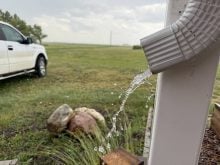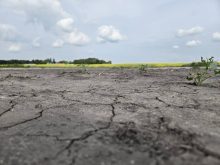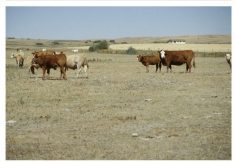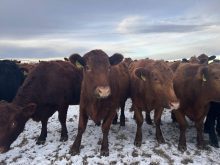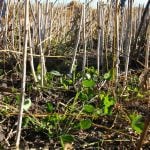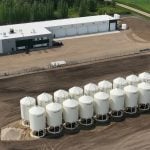Water could be in short supply in Alberta again this spring, says a director with Global Water Futures.
“Our snow packs in the mountains right now are sitting at two-thirds of normal or lower this year,” John Pomeroy told the recent Alberta Beef Industry Conference in Calgary.
“That’s dry, that’s getting as dry as the drought of 2001, 2003. It could still snow this spring, let’s hope it does, but be ready also for low river flows this spring.”
Read Also

Lethbridge Polytechnic researcher helps unlock the economics of farming
Lethbridge Polytechnic researcher Selin Karatepe is helping agriculture producers with decision-making tools in economic feasibility.
Pomeroy, a University of Saskatchewan researcher in water resources and climate change, said glaciers have played an important role providing stream flows in late summer. Alberta has benefited tremendously from having glaciers that stretch south from Jasper National Park down to Waterton National Park.
“The fact is, they are on the way out,” said Pomeroy.
He said Peyto Glacier in the Canadian Rockies in Banff National Park has been measured since 1897, with more intensive measurements beginning in 1965.
“Now it’s looking a little ragged. The glacier itself has retreated over two kilometres from the 1950s and it has retreated 450 metres in the last five years, and it’s melting downward at an incredibly fast rate. Its surface is darkening because of soot from wildfires, which increased the melt rate. It’s like a canary in a coal mine, and the canary is pretty ill. I think it’s going to be dead this decade. I don’t think Peyto Glacier will survive past 2030 in any recognizable form.”
Ice melt on glaciers has helped provide a tremendous amount of extra water to the North Saskatchewan River system over the decades, but Peyto Glacier will soon be unable to do so. This will force the province to rely less on glacier melt and more on snowpack, but the snow packs are declining as well.
Pomeroy cited the Kananaskis Valley snowpack dropping by about 50 per cent since the the 1960s.
“We are getting more warming in the Rockies than the rest of the world. The rest of the world has already warmed up by 1.5 degrees since pre-industrial levels and we are closer to 2.5 to three degrees in the Rockies,” said Pomeroy.

Waterways are intricate. The Saskatchewan River Basin has its headwaters in the Rockies and the two major rivers — the North Saskatchewan River and the South Saskatchewan River — eventually join in Saskatchewan to form the Saskatchewan River, which then flows into Lake Winnipeg in Manitoba.
“It’s a massive river basin and critically important for the Prairies. It drives our economy and cities like Calgary, Edmonton, Red Deer, Medicine Hat and Saskatoon. It feeds our major cities and two provinces,” said Pomeroy.
Climate models that forecast temperatures until the end of the century show an increase of about 5-6º C with warming occurring mostly in the winter and summer and less in the fall. Pomeroy said the hot 2023 should be considered the new norm, with increases in temperatures and drops in precipitation by the end of the century.
A combination of rising temperatures and dropping precipitation in the 50 and 100 year models is expected to produce more erratic weather patterns. The frequency of droughts is predicted to double by the end of the century.
“Perhaps we are already seeing that. We’ve had almost back-to-back droughts for six or seven years depending on where you are — also, duration of droughts increasing by about half a year by mid century,” said Pomeroy.
“But when it does rain, the multiple day rainstorms will be more intense and will increase as well. That will create opportunities and benefits along with some problems if it’s too much. The one-day extreme rainfalls are increasing and are expected to increase by one-third by the end of the century.”
Farmers have been offsetting weather challenges with more innovative practices, which has increased yields in the Prairies since the 1940s, even in drought years. Some years have been completely rain fed while during recent drought years, snow melt was crucial for crop sustainability.
“We showed the increase in yield in kilograms per hectare as a result of snow management, trapping more snow on the field. Another is by decreasing spring evaporation by leaving crop residue in place to reduce that evaporation by the end of snow melt and the end of crop growth,” said Pomeroy.
”Both snow water retention and decreasing spring evaporation, you can get about a 20 per cent increase in crop yields. In a few cases, we got an increase of 48 per cent in crop yields.”
Pomeroy said future river flows don’t look promising if present climate practices do not change.
“These are business-as-usual projections that assume that we don’t make effective reductions in greenhouse gas emissions, and it’s a pessimistic one,” he said.
“When I look at all those changes in the United States right now, and the tremendous growth of coal burning in China and India or burning there, it’s the projection we’re on.… We can still change the future.”
While Mother Nature has helped sustain Prairie agriculture up to this point, water could be less plentiful if Global Water Futures projections hold true for the mid to late century. This would force farmers to adjust on the fly with even more effective practices than they use today.
“If you’re making a living off water, and we all are to some degree, this is tough for business-as-usual climate change,” said Pomeroy.
He said that under a high-emissions climate scenario, the Prairies can expect a five degree or more increase in temperatures by the end of the century with more rainfall, except for summer, when it could be drier.
The glacial retreat and melt is accelerating, he added, with the glaciers’ contributions to the southern Alberta irrigation districts declining to the point where they will be negligible in two decades. Droughts are becoming more common, longer and severe. In between, the area will see very wet periods.
“I think we’re already starting to see that, and we’ll see more of it.”
The timing of the major mountain river discharges will move forward by about half a month by mid century and one month by late century, Pomeroy said, which mean a big change in how the agriculture industry manages its water.
There will be in a drop in June to August river flows in most scenarios, sometimes up to 50 per cent of current flows.
“That’s going to be problematic for many of our irrigation districts, our higher electricity generation and even municipal water supply in some cases,” said Pomeroy.



